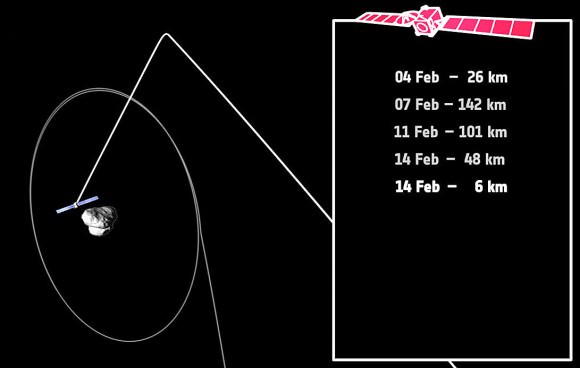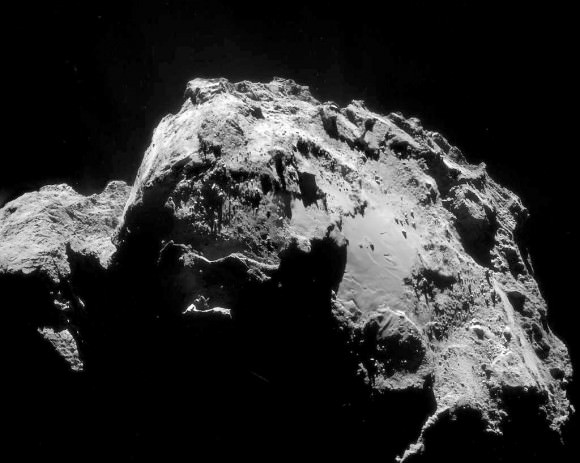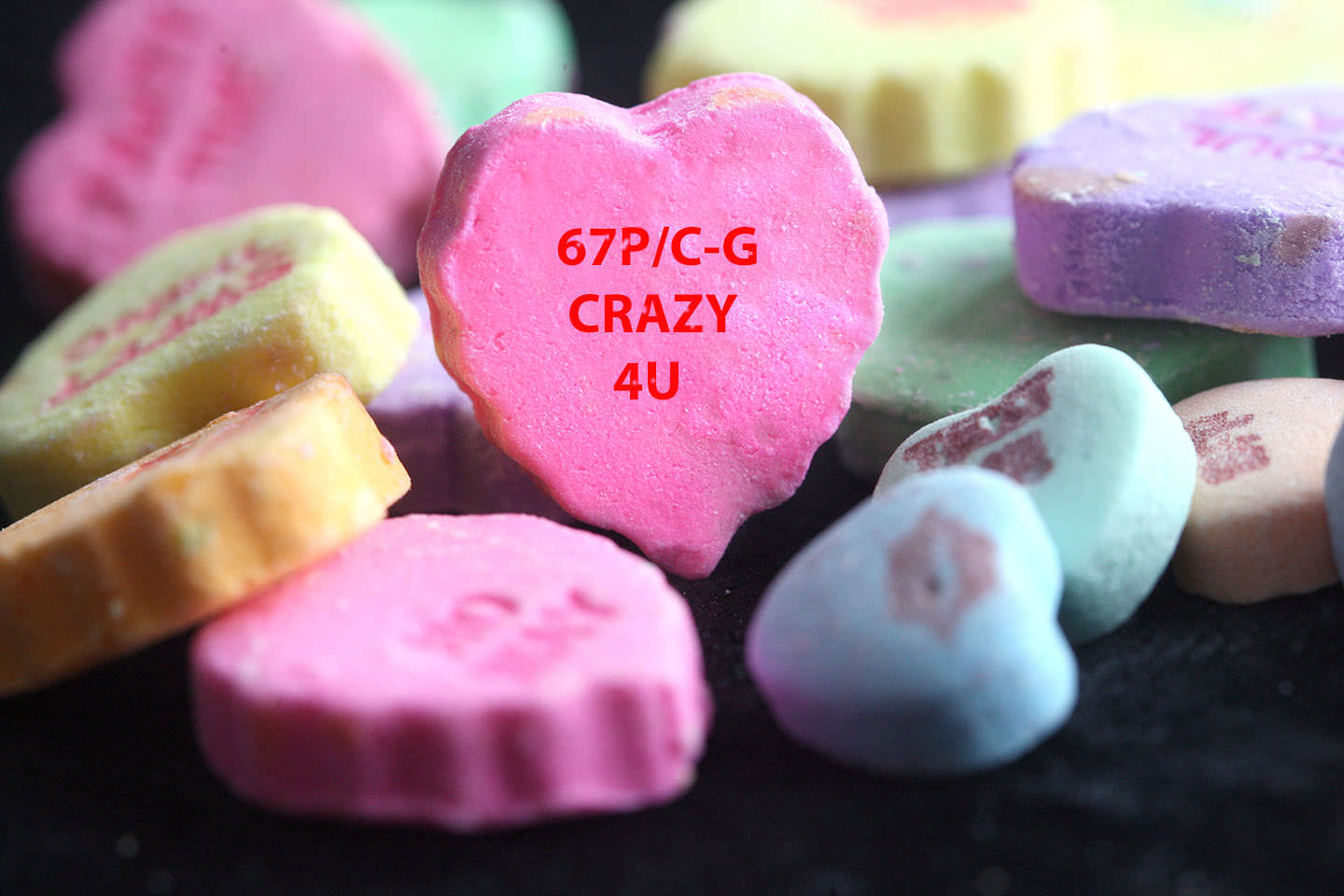Who doesn’t like to snuggle up with their Valentine on Valentine’s Day? Rosetta will practically whisper sweet nothings into 67P’s ear on February 14 when it swings just 3.7 miles (6 km) above its surface, its closest encounter yet.
Rosetta had been orbiting the comet at a distance of some 16 miles (26 km) but beginning yesterday, mission controllers used the spacecraft’s thrusters to change its orbit in preparation for the close flyby. First, Rosetta will move out to a distance of roughly 87 miles (140 km) from the comet this Saturday before swooping in for the close encounter at 6:41 a.m. CST on Feb. 14. Closest approach happens over the comet’s larger lobe, above the Imhotep region.

The close encounter will provide opportunities for Rosetta’s science instruments to photograph 67P’s surface at high resolution across a range of wavelengths as well as get a close sniff of what’s inside its innermost coma or developing atmosphere. Scientists will also be looking closely at the outflowing gas and dust to see how it evolves during transport from the comet’s interior to the coma and tail.
As Rosetta swoops by its view of the comet will continuously change. Instruments will collect data on how 67P’s dust grains reflect light across a variety of orbital perspectives – from shadowless lighting with the Sun at the orbiter’s back to slanted lighting angles – to learn more about its properties.

“After this close flyby, a new phase will begin, when Rosetta will execute sets of flybys past the comet at a range of distances, between about 15 km (9 miles) and 100 km (62 miles),” said Sylvain Lodiot, ESA’s spacecraft operations manager.
During some of the close flybys, Rosetta trajectory will be almost in step with the comet’s rotation, allowing the instruments to monitor a single point on the surface in great detail as it passes by.
Helpful animation of how ESA mission controllers are changing Rosetta’s orbit to ready the probe for the Valentine’s Day flyby.
Perihelion, when the comet arcs closest to the Sun at a distance of 115.6 million miles (186 million km), occurs on August 13. Activity should be reaching its peak around that time. Beginning one month before, the Rosetta team will identify and closely examine one of the comet’s jets in wickedly rich detail.
“We hope to target one of these regions for a fly-through, to really get a taste of the outflow of the comet,” said Matt Taylor, ESA’s Rosetta project scientist.
Yum, yum. Can’t wait for that restaurant review!


How many more comet missions will NASA need to finally admit the failure of their gravity-based models. I guess they are desperate to keep their jobs and government funding.
The mission to Temple I should have been the final straw but I am ceaselessly amazed by the perseverance of human beings. This a great strength but also can be a colossal weakness.
Temple I impact findings were a clear validation of the electric cosmology models published by Wal Thornhill and other plasma physicists. The findings also left NASA astrophysicists shaking their heads and scratching their posteriors asking “where was the water?” IMO Thornhill will be in line for a Nobel prize soon.
The reason for this remarkable sequence of events is that today’s astrophysicists and cosmologists are uneducated in plasma physics.
Ground breaking and eye-popping research is being done by plasma physicists today, particularly with magnetic fields. Laboratory findings are giving common sense answers to everything from the electromagnetic nature of atomic structure to galaxy formation. What is impressive is that experimental results match observed reality. This is a first for cosmology, a science that has relied on mathematics and today requires the breakdown of the laws of chemistry and physics for it’s theories. Of course most cosmologists can’t even spell plasma much less have an interest in plasma physics. When a hammer(gravity) is your only tool then every problem looks like a nail!!
Bob, go back to all of the recent NASA missions involving comets. They all have revealed that comets are an electromagnetic event and none of the “standard model” theories held water (no pun intended).
How about a shout out to the pioneers that predicted the truth in the face of scorn and derision from the “established” scientists. Even if you are unwilling to give proper credit, my guess is that soon the Nobel prize committee will do it for you.
nice try Mr. Thornhill
btraymd,
There is no solid evidence for the electric comet “theory”. It’s total pseudoscience. Many comets give off water vapor as they’re warmed by the Sun. We now have Rosetta right there at 67P recording increasing rates of water vaporization as the comet nears the Sun. Comets are not made of plasma. You can land on one (Philae’s sitting on 67P right now). Try landing on something made of plasma, the only representative of which in our Solar System is the Sun. I think you can guess what would happen. Also, for the record, I’m 100% certain cosmologists can spell the word ‘plasma’.
There is one place we do find plasma at comets and that’s in their ion or gas tails. Neutral molecules get ionized by UV light from the Sun and “electrified” as it were, but this is very different from saying that comets themselves are electrical or plasma phenomena. Astronomers documented ion tails many years ago.
Strange entanglement at a distance?
It’s all in our heads Bob! The matrix has us fooled good once again. The probes sent to Halley(P1) during its last perihelion? The physical damages to Giotto and the failures on the others? Imagined. You throw a dense solid metal impactor at a comet, observe the violent collision good and then confirm the results with a different probe a couple of years later? Illusion ed ! Now we have (or think we do) a probe using its very weak gravity to perform precise acrobatic maneuvers that we had not thought possible a few years ago? Conspiracy-ed !
Maybe it’s time to admit that the machines have won a very long time ago, unplug that umbilical and get it over with…
NUTS!
Thank you BC for your slyly humorous reply.
“…wickedly rich detail.” I LIKE that! But I read where Rosetta has detected co-orbiting pebble sized ejecta already. So it’s a good thing her speed in relation to the comet is so low. Regardless, were she to pass over an explosive venting, then what? White knuckled spacecraft controllers?
Will any of the flybys be dedicated to looking for Philae?
HiFarAway,
None of the flybys will be used to locate Philae. During closest approach, Philae’s not in view. Much science is on ESA’s agenda during those flybys so there’s no specific plan to seek out Philae with new images until possibly as late as next year.
If Comets are made of Plasma so is the Ice in my Single Malt Whisky (that’s why I don’t use it lol) 🙂
Make mine a couple fingers of Glen Finish. Comet water and ice in a glass back..
Comets are not made of plasma. They are solid rock with the appropriate magnetic field surrounding them. They have surface electrical activity. They are not “dirty snowballs” as predicted by NASA and have only scant surface water, nothing close to that predicted by NASA. Read the published literature…..even NASA admits they have to revise their theories while you morons cling to their lifeless bodies. I guess everyone needs something to believe in. Try religion, this science thing isn’t working out for y’all.
NASA has theories now ?
That, and the EU conspiracy theorists haven’t yet caught on that Rosetta is an ESA mission, not a NASA one. Clearly the European Space Agency has to be in on the conspiracy as well.
“…wickedly rich detail…” Haven’t heard that richly expressive adjective (wicked/wickedly) in quite a few years – and, do miss its impact… Bob, you look about my age, ha! Thanks for the article, too.
Plenum,
Thanks for your wickedly fine comment.